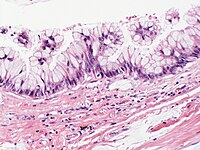
Photo from wikipedia
Background Ovarian mucinous carcinoma is a disease that requires unique treatment. But for a long time, guidelines for ovarian serous carcinoma have been used for the treatment of ovarian mucinous… Click to show full abstract
Background Ovarian mucinous carcinoma is a disease that requires unique treatment. But for a long time, guidelines for ovarian serous carcinoma have been used for the treatment of ovarian mucinous carcinoma. This study aimed to construct and validate nomograms for predicting the overall survival (OS) and cancer-specific survival (CSS) in patients with ovarian mucinous adenocarcinoma. Methods In this study, patients initially diagnosed with ovarian mucinous adenocarcinoma from 2004 to 2015 were screened from the Surveillance, Epidemiology, and End Results (SEER) database, and divided into the training group and the validation group at a ratio of 7:3. Independent risk factors for OS and CSS were determined by multivariate Cox regression analysis, and nomograms were constructed and validated. Results In this study, 1309 patients with ovarian mucinous adenocarcinoma were finally screened and randomly divided into 917 cases in the training group and 392 cases in the validation group according to a 7:3 ratio. Multivariate Cox regression analysis showed that the independent risk factors of OS were age, race, T_stage, N_stage, M_stage, grade, CA125, and chemotherapy. Independent risk factors of CSS were age, race, marital, T_stage, N_stage, M_stage, grade, CA125, and chemotherapy. According to the above results, the nomograms of OS and CSS in ovarian mucinous adenocarcinoma were constructed. In the training group, the C-index of the OS nomogram was 0.845 (95% CI: 0.821–0.869) and the C-index of the CSS nomogram was 0.862 (95%CI: 0.838–0.886). In the validation group, the C-index of the OS nomogram was 0.843 (95% CI: 0.810–0.876) and the C-index of the CSS nomogram was 0.841 (95%CI: 0.806–0.876). The calibration curve showed the consistency between the predicted results and the actual results, indicating the high accuracy of the nomogram. Conclusion The nomogram provides 3-year and 5-year OS and CSS predictions for patients with ovarian mucinous adenocarcinoma, which helps clinicians predict the prognosis of patients and formulate appropriate treatment plans.
Journal Title: Journal of Ovarian Research
Year Published: 2022
Link to full text (if available)
Share on Social Media: Sign Up to like & get
recommendations!